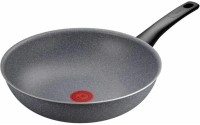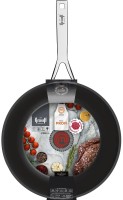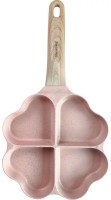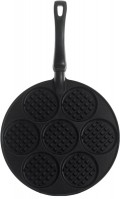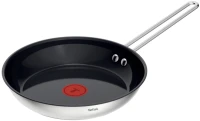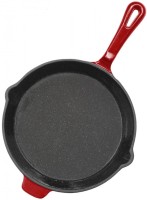How to Choose a Frying Pan
We independently test the products and technologies that we recommend.

1. Types of Frying Pans
The primary task of the buyer is to determine what tasks the frying pan is needed for and what you plan to cook on it. For example, a pancake pan is ideal for making pancakes, fritters, and crepes, but not suitable for stews. And it's impossible to stew food on a grill. Today, there are a huge number of types of frying pans:
Classic
The most popular and versatile type for everyday cooking. These are the regular frying pans found in every home: usually round in shape, with a flat bottom, walls about 3-4 cm high, and one (rarely two) handle. Such traditional cookware is suitable for frying meat and fish, stewing vegetables, making sauces, and other dishes.

Deep
Visually resembles a classic frying pan but differs with higher sides: often from 5.5 to 10 cm. This cookware is optimal for stewing and making sauces, as it holds more content. At the same time, a deep frying pan can also be used for frying — the high walls in this case prevent oil and fat splattering and help keep the kitchen clean.

Sauté Pan
A mix of a frying pan and a pot in one device. Essentially, it's the same deep frying pan, only with even higher sides. Its main purpose is stewing and simmering when you need to process a large amount of food with liquid. However, sauté pans are also suitable for frying.

Roaster
Another variety of deep cookware with high walls and a thick bottom, combining the capabilities of a frying pan and a pot. The purpose is similar — primarily stewing and simmering, as well as regular frying. The main feature of roasters is the presence of two small handles, which provide a more convenient grip.

designed primarily for stewing and simmering.
Wok
A special frying pan for preparing Asian cuisine dishes: noodles, fried rice, tempura vegetables — in general, everything that requires quick frying due to the instantly heating bottom. These pans have a specific shape with a small diameter bottom and thin walls that widen upwards. During cooking, the contents need to be constantly stirred, moving the food from the hot bottom to the cooler walls. Besides quick frying, the wok is also suitable for stewing due to its high walls.

Grill
A special frying pan with a ribbed surface, designed for frying large pieces of meat, fish, vegetables, etc. Thanks to the ribbed bottom, it provides appetizing grill marks on the product during cooking. Essentially, it's an inexpensive alternative to cooking steaks using an outdoor grill or a contact electric grill. Most grill pans are square or rectangular, although there are also models of the classic round shape.
Additionally, there are several subtypes of grills:
- Double-sided grill — a pan consisting of two parts connected to each other, mainly with a smooth and ribbed surface. One of them acts as the bottom during cooking, the other as a lid, thus ensuring airtightness and even cooking.
- Gas grill — special pans for gas stoves with a corresponding cutout for the burner and a lid. They allow you to set up something like a barbecue area in the kitchen.
- Grill plateau — large elongated cookware for cooking a large amount of food at once. Often, such pans occupy several burners of the stove or cooktop.

provides appetizing grill marks on products.
Pancake Pan
Special pans designed exclusively for frying: primarily pancakes, as well as fritters, crepes, and similar dishes. These models have a classic round shape, feature low sides for easy batter distribution, and a thin bottom for instant heating.

For Fritters
A variety of pancake pans with several indentations, thanks to which fritters are of the same size and shape. Usually, there are 3-4 to 6-7 indentations of round, triangular, or other shapes. Accordingly, due to the design features, such pans are only suitable for frying fritters and similar flour products.

For Waffles
Another variety of shaped pans with special relief forms for making waffles.

For Paella
Special pans designed for preparing the national Spanish dish — paella. They feature a special shape with low, sloping sides and two short handles.

For Fish
Similar to classic frying pans but differ with an oval elongated shape, like a fish. Thanks to this, the fish can be cooked whole, it is evenly fried on all sides, including the sides, and retains its juiciness. These models can have a regular smooth bottom or ribbed, like grills.

Flip Pan
A not very common type of deep frying pan, the main feature of which is the side with different heights on the sides. The walls are lower near the handle and higher on the opposite side. This is done to make it easier to toss the frying ingredients instead of regular stirring. However, this requires certain skills from the cook.

Tajine
Special cookware for preparing the dish of the same name made from meat and vegetables, which is cooked in Morocco and nearby regions. It is something between a frying pan and a bowl, has thick walls and a high conical lid. During slow long stewing, the rising steam condenses in the relatively cold upper part of the lid and flows down. The prepared dish is usually eaten directly from the pan.

Portion
A pan with a dual purpose: you can not only cook in it but also serve dishes. These models usually have a small size, two short handles instead of one long one, and a durable coating that is not afraid of contact with metal utensils. The set may also include a wooden stand so that the hot pan can be safely placed on the table.

For convenience, we have summarized all of the above in a table:
| Type of Pan | Main Use | Features |
|---|---|---|
| Classic | Universal: frying, stewing, simmering | Flat bottom, low walls (about 4 cm) |
| Deep | Frying, stewing, making sauces | High sides (from 5.5 to 10 cm) |
| Sauté Pan | Stewing and simmering products with a large amount of liquid | High walls, like a pot |
| Roaster | Primarily stewing and simmering, as well as frying | High walls, thick bottom, and two small handles |
| Wok | Quick frying, preparing Asian cuisine dishes | Small diameter bottom and thin walls widening upwards |
| Grill | Frying large pieces of meat, fish, vegetables, etc. with appetizing grill marks | Ribbed bottom surface |
| Pancake Pan | Frying pancakes | Round shape, low sides, thin bottom |
| For Fritters | Making fritters | Several holes of the same size and shape |
| For Waffles | Making waffles | Special relief forms |
| For Paella | Making paella | Low, sloping sides and two short handles |
| For Fish | Frying and baking fish | Elongated shape for whole fish |
| Flip Pan | Stirring ingredients by tossing | Side with different heights on the sides |
| Tajine | Making the dish of the same name from meat and vegetables | Thick walls and special conical lid |
| Portion | Cooking and serving dishes in one cookware | Small size, two short handles, durable coating, often a wooden stand included |
2. Sizes and Diameter
The next important step when choosing a frying pan is its diameter. The larger it is, the more spacious the pan. Manufacturers always indicate this parameter in the specifications and on the label. The most common models are 24, 26, and 28 cm in diameter — these are optimal sizes for everyday cooking.
Note that the diameter of the top circle is important for selecting a lid — it should be the same size as the pan. Ideally, the lid should be included in the supply set — in this case, it will be a perfect addition. If the lid needs to be purchased separately, choose the same diameter as the pan.
At the same time, it's important to consider the diameter of the bottom — it should approximately match the size of the burner (in the case of electric stoves) or the flame on gas burners. The pan can be larger than the burner, but not by much — otherwise, the food will cook unevenly, as the bottom will heat well in the center and insufficiently on the sides. If the bottom is smaller than the burner, there is a risk of overheating and damaging the coating of the side walls when in contact with open flame. And while on gas stoves you can still adjust the power and size of the flame, electric cooktops require matching the size of the cookware and heating zones.
3. Materials
The lifespan and quality of cooking directly depend on the material from which the pan is made. In addition, each material requires special care. The most common materials are 4:
Cast Iron
Cast iron pans have a long history spanning several centuries. At the same time, cast iron is still in demand today. It is a heavy and durable material that retains heat well. It heats evenly, withstands high temperatures well (including being able to cook in the oven). Thanks to its porous structure, cast iron can accumulate fat from food, which over time creates a natural non-stick coating and improves its performance. Moreover, it is a durable and inexpensive material — cast iron pans are usually much cheaper than non-stick ones. They are suitable for both frying and stewing.
But cast iron also has serious drawbacks. Firstly, it is heavy and brittle (though durable) — if dropped on a hard surface, the pan may crack. Secondly, with improper care, food will burn, and if not dried thoroughly after washing, the pan may rust. Cast iron requires care to last as long as possible: periodically coat the surface with heat-resistant sunflower oil (refined), then put the pan on the fire, cool it, and wipe it with a paper towel. Using detergents and a dishwasher is not recommended.

Stainless Steel
This is the most popular material in professional kitchens because it is easy to maintain, has a good lifespan, does not release harmful substances, does not react with food, is durable, does not deform, and is lightweight. Steel is not afraid of metal spatulas, but it increases the risk of food burning (unless the pan has a non-stick coating). At the same time, stainless steel models quickly lose their shine and presentable appearance and do not like abrasive detergents — scratches may appear on the surface.

Aluminum
A budget, but not the highest quality material. Such pans are lightweight, convenient to use, and in most cases have a non-stick coating, as pure aluminum will lead to food burning. However, the lifespan of such cookware is limited, and with strong heating, the pans swell and their bottom deforms. Therefore, it is better to choose models with a thick bottom — at least 5 mm.
Aluminum pans without coating are very "capricious": they do not like acidic and spicy dishes, as the interaction of organic acids with aluminum spoils the taste of the cooked food. Such pans should be washed by hand using a soft sponge. Fortunately, such models are quite rare, most often aluminum serves as a base and is combined with various types of non-stick coatings.
In turn, there are several types of aluminum:
- Stamped aluminum — the simplest and cheapest material, which is not distinguished by thermal conductivity, durability, or resistance to deformation.
- Forged aluminum — a more durable material that does not deform as much with overheating and temperature fluctuations.
- Cast aluminum — the highest quality and most durable, as it has a decent thickness and ensures even heating.

as a base for inexpensive pans with a non-stick coating.
Copper
The main advantage of the material is its high thermal conductivity. In addition, the advantages include quick and even heating, antibacterial properties, as well as an aesthetic appearance with a golden hue. However, this is a rather expensive material, resulting in copper pans having a high cost. And they need to be properly cared for: do not wash in a dishwasher, use special detergents, otherwise, copper will quickly lose its beautiful appearance.

To avoid confusion in all this description, we have compiled a comparative table with the advantages and disadvantages of these materials:
| Pros | Cons | |
|---|---|---|
| Cast Iron |
|
|
| Stainless Steel |
|
|
| Aluminum |
|
|
| Copper |
|
|
4. Types of Non-Stick Coating
In addition to the material, the coating of the pan plays an important role in its quality. Non-stick coating prevents food from sticking and burning, and also increases the thickness of the bottom, which affects cooking efficiency, thermal conductivity, and heat retention. In addition, the coating determines the lifespan and usage features of the pan.
Teflon (also known as polytetrafluoroethylene)
The most common material on the modern market, primarily due to its affordable price. This coating is very smooth, so it is easy to wash. Excellent non-stick properties allow frying with a minimal amount of oil or even without it, which is especially important for athletes and people following a healthy diet.
But Teflon coating also has its drawbacks. Firstly, it does not like high temperatures — above 200 degrees, Teflon forms toxic compounds. Secondly, the coating has a limited lifespan: even a quality pan will need to be replaced approximately every 5 years, and a budget one even more often. Thirdly, scratches and chips are unacceptable, as with their appearance, the pan is no longer suitable for use — Teflon begins to release harmful substances. That is why Teflon-coated cookware cannot be washed with abrasive substances and hard sponges, and when frying, it is forbidden to use metal spatulas, forks, spoons, and other accessories — only silicone or wooden ones.

requires careful use, and has a limited lifespan.
Ceramic
It is considered the most environmentally friendly coating, as it is completely harmless and does not release harmful chemicals. It is a hard and durable material, much stronger than Teflon. It easily withstands high temperatures (even up to 400-500°C), has good non-stick properties, allows cooking with minimal oil, and is resistant to scratches, so it can be used with spatulas and accessories made of any material, including metal. The weak point of ceramics is temperature fluctuations: a hot pan cannot be washed with cold water, nor can frozen products be placed in it.

Marble and Granite
In this case, we are not talking about a solid material, but about a non-stick coating (often Teflon) with inclusions of stone chips: marble, granite, etc. It is less prone to mechanical damage, more durable, and wear-resistant. At the same time, this coating, like any non-stick, requires careful use.

Titanium
The coating based on titanium oxide is environmentally friendly, harmless to health, and also the most durable, wear-resistant, and strong. With it, you can safely use metal kitchen utensils (although this still needs to be clarified with the manufacturer of a specific model). At the same time, titanium is an expensive material, so pans with titanium coating are quite expensive.

Enamel
A strong, safe, and easy-to-maintain coating suitable for any type of cookware. Enamel is used to coat metal utensils to prevent contact of products with metal ions. Enamel is resistant to scratches and easily withstands interaction with metal utensils. The disadvantages include the need to add a sufficient amount of oil to prevent food from burning, weak thermal conductivity, and a tendency to chip with careless use. Rust forms in places where the enamel is damaged. Enamel-coated pans are quite rare.
| Pros | Cons | |
|---|---|---|
| Teflon |
|
|
| Ceramic |
|
|
| Stone (Marble and Granite) |
|
|
| Titanium |
|
|
| Enamel |
|
|
Thus, the body material determines how quickly and evenly the pan heats up, and therefore the quality of the dishes. And the non-stick coating determines the ease of use and the types of dishes that can be cooked. Therefore, it is important to consider both parameters. There are also many models without non-stick coating — in this case, you need to rely only on the body material.
5. Features
When choosing a frying pan, it is important to consider not only the materials and coating but also other features that affect ease of use.
Handle
Handles for frying pans are made of metal, wood, bakelite, silicone, or cast iron. Metal and cast iron cannot be called convenient, as they heat up a lot. Wood is sensitive to moisture and dirt, silicone — to high temperatures. Therefore, one of the most popular materials is bakelite (a type of plastic) — it does not heat up, is quite durable, and is easy to clean. In general, the handle should fit comfortably in the hand, not slip, not wobble, and not heat up to avoid burning bare hands.
A useful feature is a removable handle — with it, pans can be used in the oven, easier to store and transport, as the cookware and the handle separately take up less space.
In addition, there are folding handles, which also save space when storing. They are mainly found in square and rectangular grill pans.

Lid
Most often they are made of glass so that you can observe the cooking process, less often — of metal. The lid should fit in size. Ideally, it should have a removable handle — this makes it easier to clean from accumulated grease and dirt. Most pans are sold without lids — you can use an old one (if it fits in size) or buy it separately. However, there are models with a lid included.
6. Additional Features
Bottom. In addition to the diameter, the thickness of the bottom is also important — the thicker it is, the more durable the cookware. The same applies to the thickness of the walls. There are also many models with a multi-layer bottom — it consists of different materials, which increases strength and resistance to high temperatures.
Owners of induction cooktops need to consider the compatibility of the cookware with the stove, as their operating principle is different: the heaters transfer heat not to the burner, but directly to the cookware. Therefore, they are compatible only with pans with a special induction bottom — otherwise, you will not be able to cook. Today, most pans have this compatibility, but it is still better to clarify this point. Information about the induction bottom is always indicated on the label and in the specifications, and this marking also indicates it:

Thermosensor — an indicator that signals the heating of the pan. In most cases, it is a small insert in the center, made of a sensitive material that changes color when the optimal cooking temperature is reached.
Drain Spout — a spout that allows you to conveniently drain excess oil and pour the contents into narrow cookware.
Use in the Oven — the ability to place the pan not only on the stove but also in the oven to cook one dish without the need to change cookware. For example, if you need to finish a steak in the oven. Such models are made of durable materials (cast iron, steel) that withstand high temperatures and have either removable or metal handles. Manufacturers always indicate the possibility of using in the oven, so if this information is not specified in the specifications — it is better not to experiment.
Internal Partitions — dividers of the working surface that allow you to cook several dishes at once. There can be two, three, or more of these zones. There are even models with different surfaces and shapes of zones: smooth and ribbed, round and rectangular. However, if you want to cook one dish — the partitions cannot be removed. And it is not possible to set the optimal heating for each dish.
Dishwasher Safe — due to the peculiarities of the process, not all pans (especially with delicate coatings) are suitable for washing in a dishwasher. Therefore, if you do not want to wash the dishes by hand, you should make sure of compatibility with the dishwasher. This information is also indicated by the manufacturer in the specifications.
7. Popular Brands
When buying a frying pan, you should not focus only on the brand, but this point should still be considered. After all, many large companies have established themselves as manufacturers of quality, durable, and reliable cookware. Among them:
- Tefal — a French brand, pioneer of non-stick coating. Offers a wide selection, including aluminum, steel, and ceramic pans for any budget.
- Brizoll — a Ukrainian brand specializing in cast iron cookware. The pans are durable and long-lasting, as well as environmentally friendly and often without coating.
- Fissman — a company from Denmark. Produces aluminum and ceramic pans, including specialized models for pancakes and grills. The products often have a bright design.
- Krauff — a German cookware brand with quality materials and ergonomic design. Produces both universal and specialized models with an optimal price-quality ratio. Multi-layer non-stick coatings are often used, ensuring durability and even heating.
- Berlinger Haus — a company from Hungary that produces pans with a stylish design, multi-layer non-stick coating, often with marble addition. The range includes both universal and specialized models.
- BergHOFF — a manufacturer from Belgium that produces not cheap pans with a stylish design. The range includes many models made of ceramic and stainless steel.
8. So What to Choose?
In conclusion, we emphasize that when choosing a frying pan, you need to consider many factors: budget, frequency of use, stove features, dishes being prepared, and operating conditions. In any case, the pan should match your culinary habits and preferences. Therefore, here are some recommendations:
- For universal use, aluminum pans with a non-stick coating are suitable. They are lightweight, heat up quickly, and are easy to maintain, but require careful handling to avoid damaging the coating.
- For stewing and long simmering, it is better to choose cast iron pans. They retain heat, withstand high temperatures, but require care to avoid rust.
- For cooking dishes with minimal oil, models with a ceramic coating are suitable, which are environmentally friendly but require careful handling.
- For frying meat and vegetables with a characteristic pattern, it is worth choosing a grill pan. It is suitable for all types of stoves and allows cooking dishes without excess fat.
- For baking pancakes or omelets, specialized pans with low sides and good non-stick coating are suitable.
Articles, reviews, useful tips
All materials























































































